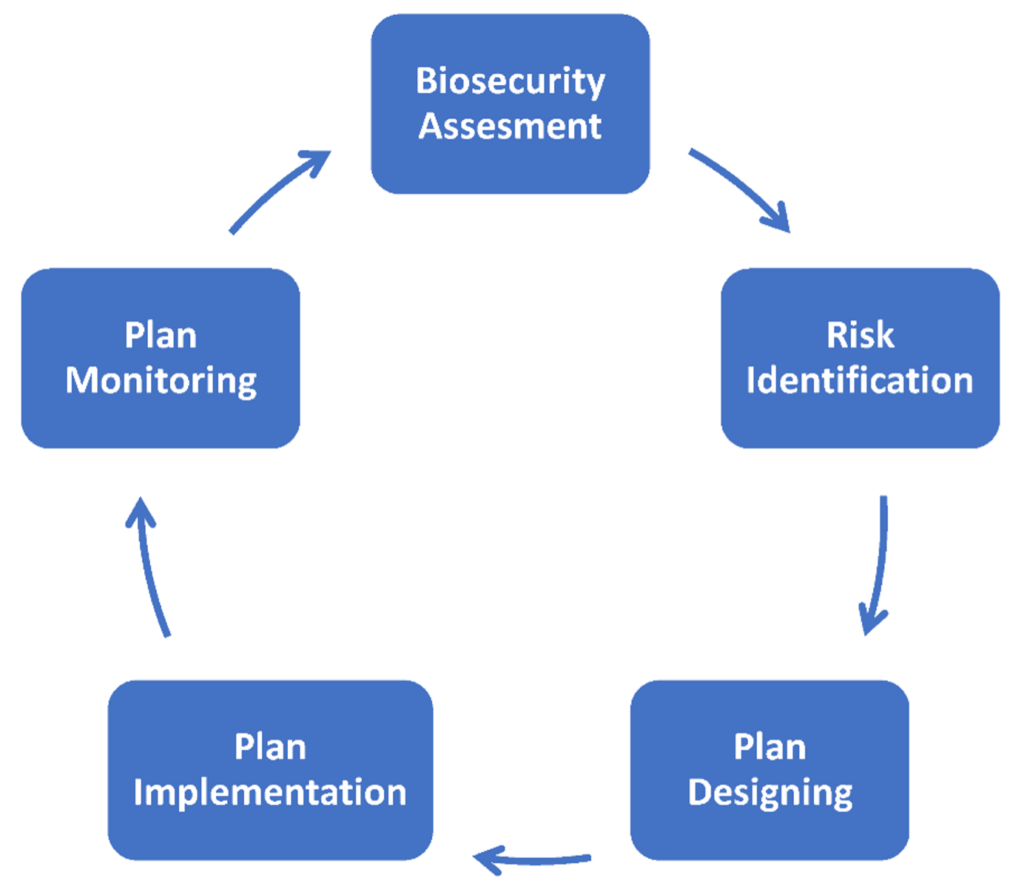Biosecurity Plan
“If You Fail to Plan, You Are Planning to Fail” — Benjamin Franklin
To facilitate smooth farm operations and ensure good farm biosecurity, it is essential to have a plan. This module will demonstrate why farms need a biosecurity plan and how to create one.
Creating a Biosecurity Plan
Most farmers practice some biosecurity measures, and you may have learned more measures in previous modules. In addition to following best practices, it’s important to have a written biosecurity plan for your farm. When creating a biosecurity plan, farmers should:
- Assess the current biosecurity measures of your farm.
- Identify missing biosecurity measures and risk factors that could threaten the health and productivity of your livestock.
- Provide a biosecurity plan and develop written biosecurity protocols to cover your farm’s biosecurity gaps and reduce the risk of disease.
- Train all employees on how to implement your biosecurity protocols.
- Monitor your plan regularly to evaluate the efficiency of your biosecurity protocols and to identify any biosecurity threats not addressed by the protocols.

Experienced beef cattle farmers, biosecurity officers, or veterinarians can help assess your farm’s current biosecurity measures. You can also use online and offline available tools to evaluate your farm biosecurity structure. These tools are questionnaires containing several questions to assess your farm’s biosecurity measures.
Biosecurity assessment is crucial because it provides a comprehensive look at your operation to gauge various strengths and weaknesses in preventing diseases from entering and spreading on your farm.
Biosecurity assessments are not costly. It is a cost-saving step that can prevent losses by detecting problems before they become severe and lead to farm losses.
Secure Beef Supply (SBS) Plan and Use
Foot-and-mouth disease (FMD) is a highly contagious foreign animal disease that affects cattle and other farm animals. While FMD can affect the health of cattle herds, there is no food safety or public health concern from this disease.
The Secure Beef Supply (SBS) plan is a continuity of business plan for cattle operations that helps beef cattle producers voluntarily prepare before an FMD outbreak. The SBS plan guides how to better control the spread of FMD by restricting animal and animal-product movements in and around areas with infected animals. After an FMD outbreak, all movements would require special permits, which regulatory officials can issue after meeting specific requirements. More details about the SBS plan are available in this Guide to the Secure Beef Supply Plan.
Steps for writing your SBS plan
- Familiarize yourself with the SBS Plan for Continuity of Business website
- Obtain a Premises Identification Number (PIN)
- Write and implement an enhanced biosecurity plan
Template for an enhanced biosecurity plan
Example of an enhanced biosecurity plan
- Create and label premises maps
Sample: Premises Map Instructions: Feedlot
Sample: Premises Map Instructions: Pasture
- Keep all movement records
Sample: Animal Movement Log
Sample: People Entry Log
Sample: Vehicle/Equipment Entry Log
How to implement your SBS plan
- Create a site-specific enhanced biosecurity plan that details measures that will be taken during a foreign animal disease outbreak.
- Prepare for periods of restricted movement.
- Record all movements of animals, personnel, visitors, vehicles, equipment, and other items.
- Train your employees how to:
- Recognize animals infected with FMD
- Keep records
- Collect samples
- Send reports
What’s Next?
Hopefully, now you have a good understanding of how to protect your cattles’ health and your production from loss by adopting biosecurity according to your farm’s needs and requirements.
To learn more, check our resources tab.
